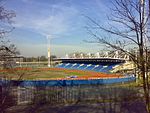Anerley
Areas of LondonDistricts of the London Borough of BromleyUse British English from December 2013

Anerley () is an area of south east London, England, within the London Borough of Bromley. It is located 7 miles (11 km) south south-east of Charing Cross, to the south of Crystal Palace and Upper Norwood, west of Penge, north of Elmers End and South Norwood.
Excerpt from the Wikipedia article Anerley (License: CC BY-SA 3.0, Authors, Images).Anerley
Anerley Park, London Crystal Palace (London Borough of Bromley)
Geographical coordinates (GPS) Address Nearby Places Show on map
Geographical coordinates (GPS)
| Latitude | Longitude |
|---|---|
| N 51.4147 ° | E -0.067 ° |
Address
Castledine Road
Anerley Park
SE20 8AP London, Crystal Palace (London Borough of Bromley)
England, United Kingdom
Open on Google Maps









